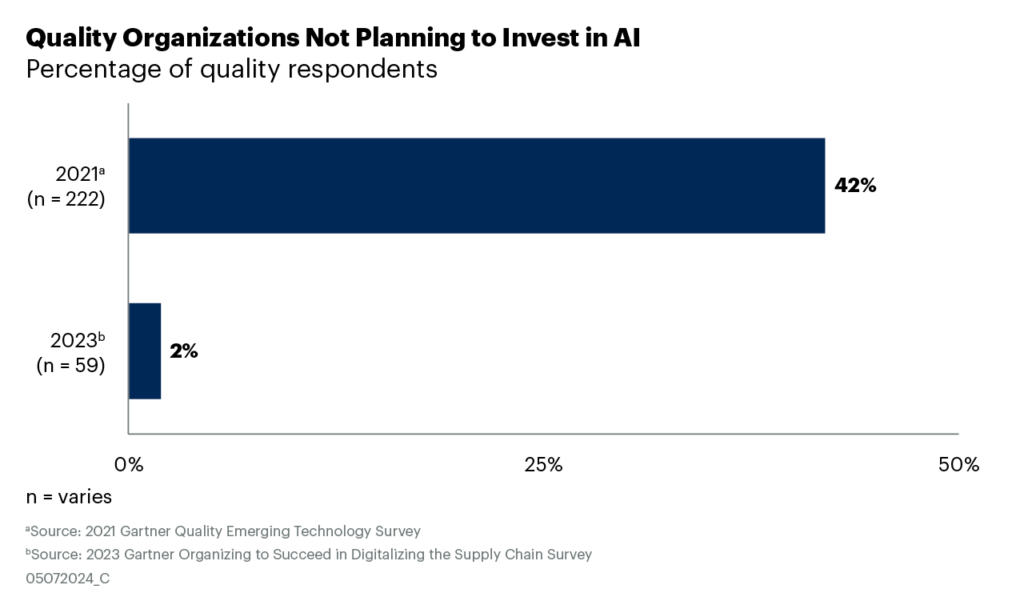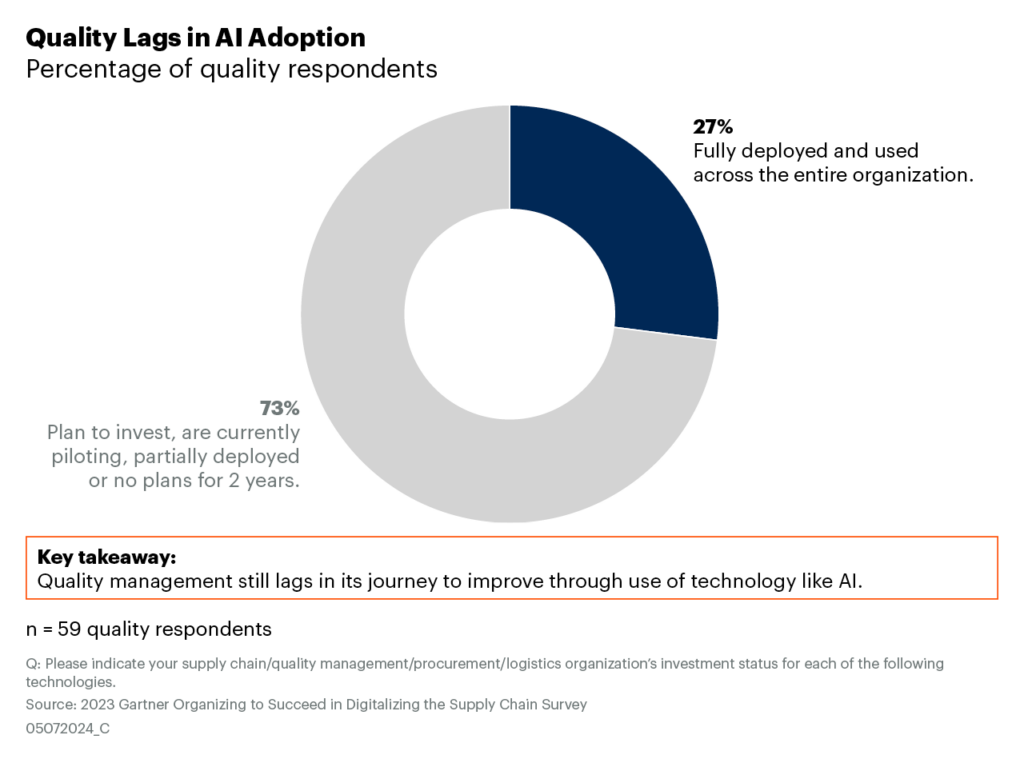Artificial intelligence seems to be everywhere, dominating business headlines and becoming a hot topic of conversation at corporate strategy sessions. We’re now seeing AI being used in real-life daily applications, from writing college admissions papers for teenagers to identifying ubiquitous dog breeds to even restoring aged works of art.
Yet is all that glitters gold?
The hype on AI

With the explosion of fancy new AI techniques in headlines over the past year, many quality leaders feel behind on their own AI journeys. Facing a phenomenon akin to peer pressure, they feel that because their peers are adopting AI, they must too. In 2021, when Gartner asked quality leaders if they were planning on investing in AI, 42% of them said no. In 2023, when asked the same question, only 2% of quality leaders responded no (see first figure below). This hype surrounding AI is real, and now translates into real budget considerations.
Given the impact of AI use cases on quality management, it’s important to determine fact from fiction.
AI use cases for quality bring significant value to supply chain organisations. They help to increase efficiency by exceeding performance goals with fewer resources, reducing overall cost. Such use cases also manage risk when successfully deployed by reducing warranty costs, recalls, yield holds and customer complaints — to name a few examples. Some cases even show AI bringing in new revenue streams, if implemented correctly.
Yet despite the uptick in investment plans, there is still confusion about how to start. There are so many assumptions regarding AI. As for AI’s use in quality management, however, not all these assumptions are true.
Assumption busting
Before quality organisations rush to implement AI, it is important to go over the two most common assumptions that Gartner encountered when speaking to quality leaders:
All my peers are ahead of me in adopting AI
AI can bring quick wins to my organisation if done correctly
Assumption 1: All my peers are ahead of me in adopting AI

Many organisations feel pressure to adopt AI. Because of that pressure, they make investment plans and begin exploring use cases, fearing that they are behind their peers. Yet, really, leaders tend to overestimate the progress that their peers have made with AI.
Only 27% of quality organisations report fully deploying and using AI across the entire organisation (see next figure below). Fully deployed means that the technology is used in a variety of sites across the network, as opposed to just one. This means most peer organisations are still in the nascent stages of AI adoption, despite that misconception.
Leaders can breathe a sigh of relief knowing that they aren’t alone if they’re still in the piloting phases with AI. With the seemingly constant reporting of new AI techniques in headlines, it is natural to assume that AI is more common than we think.
Assumption 2: AI can bring quick wins to my organisation if done correctly
There are many benefits to using AI, and quality leaders can often assume that these benefits will be nearly immediate.
In conducting research for prominent AI use cases in quality management, 15 foundational use cases were identified. Gartner analysts scored and aggregated these use cases along several dimensions to calculate implementation feasibility and business value. Once scores were finalised, a surprising finding emerged. None of the use cases scored as a “likely win” for organisations — meaning, no use case identified is seen as having both high business value and high feasibility.
The low deployment of AI across organisations makes sense, as there is no such thing as an easy win when it comes to AI in quality management. Therefore, leaders should not go about trying to cherry pick what may seem like an easier AI use case for a quick win. The fact is, for quality organisations looking to also manage risk and increase efficiencies of their operations, the path to AI will not be easy.
Coming to terms with reality
The good news is that, when it concerns AI, organisations should not feel left behind or pressured to make a quick investment. AI is here to stay. Organisations need to approach it by treading lightly with concerted effort and understanding exactly which use cases they want to pursue.
Originally posted on Gartner





